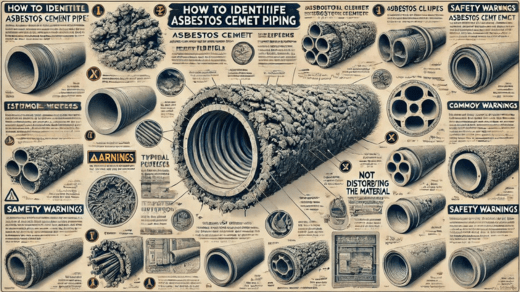It can be difficult to identify asbestos cement in a home or workplace. There are hundreds of various places in a building that could contain asbestos. Asbestos was not known to be dangerous or harmful to health in the past, so we shouldn’t expect a warning sign on asbestos-containing materials in a building.
The UK banned using asbestos in building materials in 1999, but every year there are still around five thousand asbestos related deaths. It is estimated that in the there are around 1.5 million buildings containing harmful asbestos materials, including cement.
The list of asbestos cement products is extensive. It ranges from roof sheeting and tiles to pipes, including those found in drains, flues, and guttering, to cement water tanks.
Until the beginning of the 21st century, chrysotile, also known as white asbestos, was the most common asbestos in piping.
Other types of asbestos can be found in pipework as well. This includes wraps, insulation, and hard-set asbestos. These types of asbestos pose a high health risk. Knowing what type of asbestos you are dealing with is particularly important.
Why Asbestos Pipes?
Asbestos pipes were introduced in Italy in 1913 and soon became popular throughout Europe due to their high resilience, low corrosion, and easy manufacturing process. By the mid-20th century, asbestos cement pipes were commonly used to create water mains across the UK, particularly in London. So if you live in the capital it is advisable to find an asbestos survey in London company to test your property. The success of this product led to the widespread adoption of asbestos cement in water pipes and sewer mains throughout the 1950s and 1960s.
What To Look For
Asbestos cement pipes are predominantly off-white or light grey but can be painted or covered with various coloured materials, such as black bitumen.
Although these pipes are now seen less in residential properties, they are still present in many homes.
If you think your home or property has a drainage system with asbestos pipes or you have concerns relating to asbestos in your home, contact a professional asbestos surveyor who can test for asbestos on your property or a drainage company, like this drain unblocking in Kent firm.
Modern Downpipes, Drainpipes, And Gutters
Modern gutters, drains and downpipes are now made from various safe materials, including PVC and plastic. Nevertheless, asbestos was widely used before the year 2000 and particularly typical before 1980, when the use was prolific.
Are Asbestos Drainage Pipes Dangerous?
When you recognise you have asbestos pipes on your property, you might think you’re in immediate danger. While it’s true that asbestos is a hazardous material, many factors decide how risky your pipes are and their implications for your health.
Age
Asbestos pipes often become flakier and more damaged with age. If broken, asbestos is friable, which increases the chance of airborne fibre release. Where adequately maintained, asbestos cement piping has a lifetime of around fifty years.
Condition
If you have Asbestos cement pipes on your property, you don’t have to worry too much if they are in good condition and sealed. But, if damaged, broken, worn out, or eroding, they can pose a serious health hazard. To be safe, get an asbestos survey to assess the potential risks associated with these pipes.
Location
Pipes in areas where people don’t move around a lot are not as dangerous as those with high traffic. If your pipes are buried underground, it’s better to leave them alone and not touch them. However, if you can see any damaged pipes made of asbestos, it’s best to remove them.
Don’t try to do any asbestos removal work yourself. This is a dangerous task that should be left to trained professionals.

